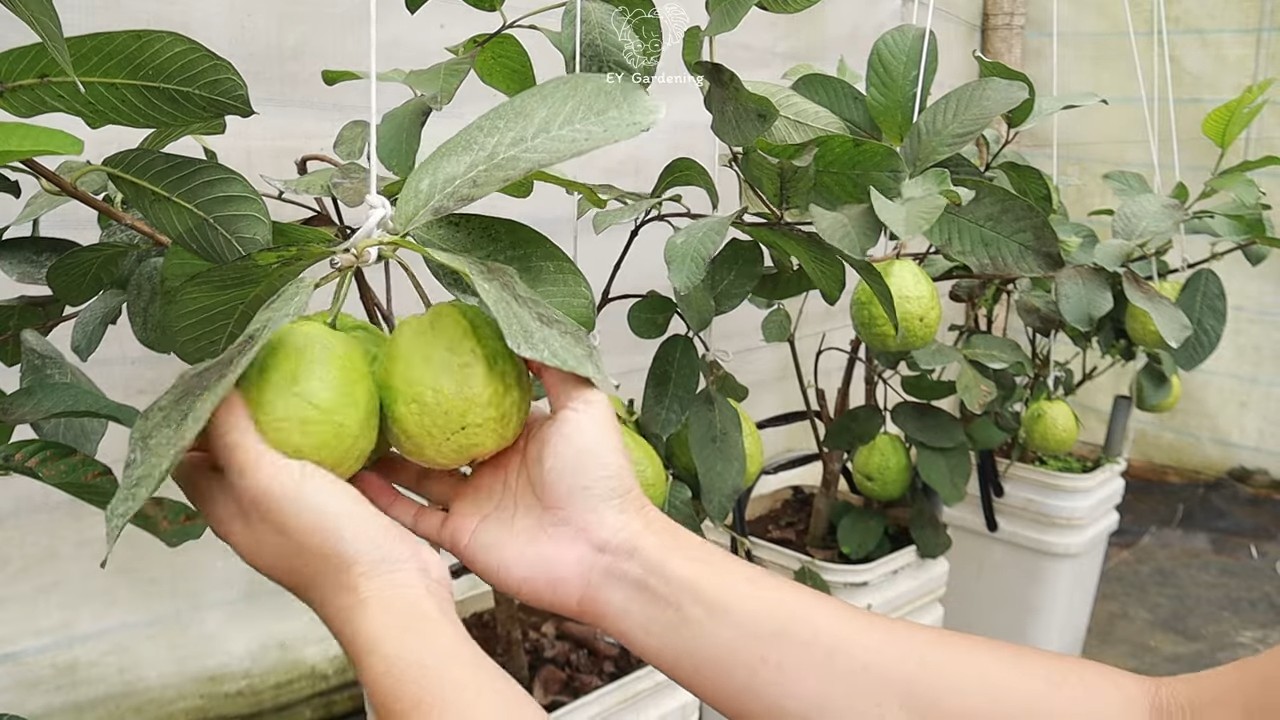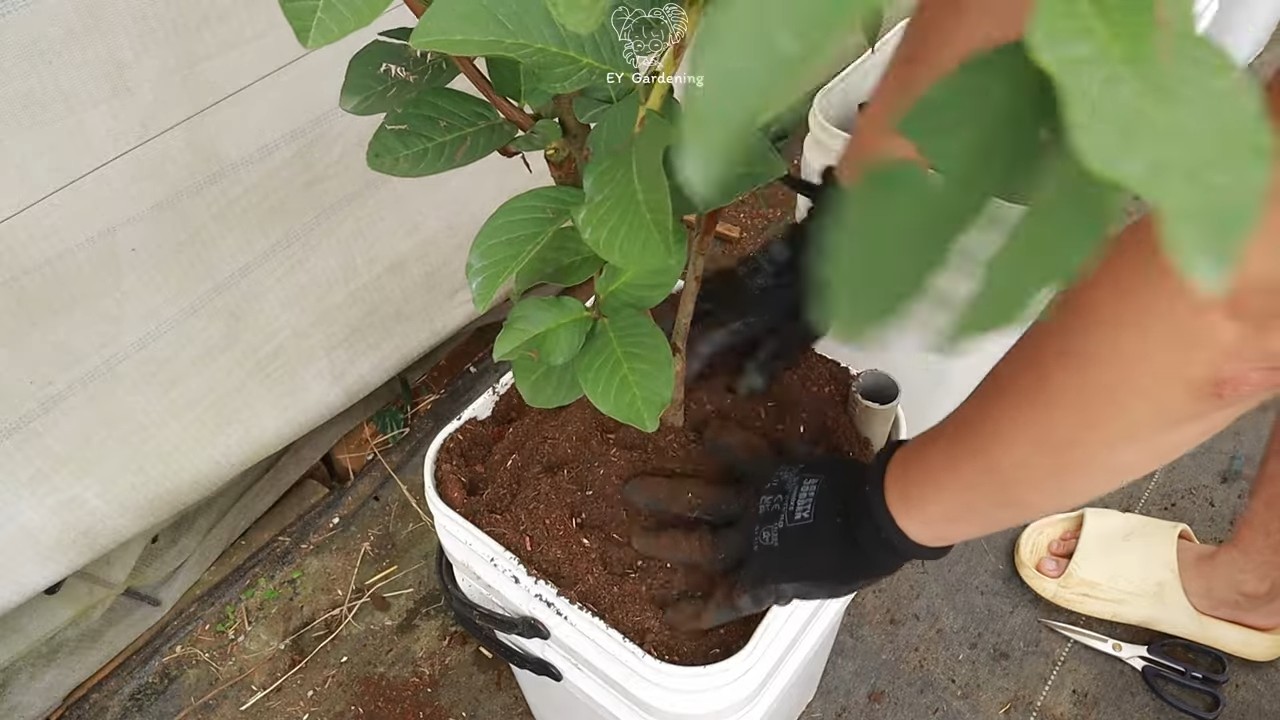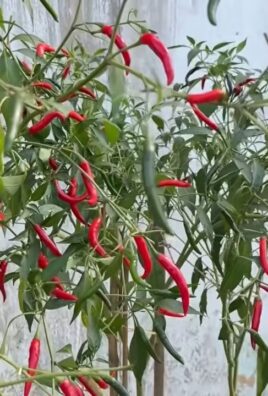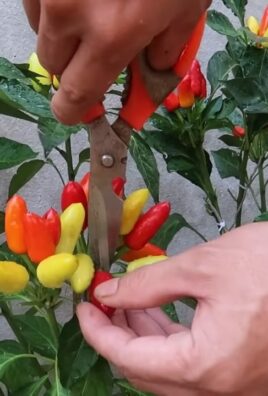Terrace guava tree planting might seem daunting, especially if you’re picturing sprawling orchards rather than your cozy outdoor space. But trust me, growing your own delicious guavas on your terrace is absolutely achievable, and incredibly rewarding! Imagine stepping outside to pluck a sun-ripened guava, bursting with tropical flavor, all thanks to your own green thumb.
Guava trees have a rich history, deeply rooted in tropical and subtropical cultures worldwide. From ancient medicinal uses to being a symbol of abundance and good fortune, guavas have been cherished for centuries. Now, you can bring a piece of that history and a taste of the tropics right to your home!
Why should you consider terrace guava tree planting? Well, beyond the sheer joy of harvesting your own fruit, it’s a fantastic way to connect with nature, even in an urban setting. Plus, store-bought guavas simply can’t compare to the flavor of a freshly picked, homegrown one. This DIY guide will walk you through every step, from choosing the right variety to providing the perfect care, ensuring your guava tree thrives and graces your terrace with its beauty and bounty. Let’s get started and transform your terrace into a mini guava paradise!

Planting a Guava Tree in a Terrace Garden: A Step-by-Step Guide
Hey there, fellow gardening enthusiasts! Ever dreamt of plucking fresh, juicy guavas right from your own terrace? Well, you’re in the right place! I’m going to walk you through the entire process of planting a guava tree in a container on your terrace, ensuring you have a thriving, fruit-bearing beauty. It might seem daunting, but trust me, with a little patience and the right steps, you’ll be enjoying homegrown guavas in no time.
Choosing the Right Guava Variety
Before we get our hands dirty, let’s talk about guava varieties. Not all guavas are created equal, especially when it comes to container gardening. You’ll want to choose a dwarf or semi-dwarf variety that’s well-suited for growing in pots. Here are a few popular options:
* ‘Red Indian’ Guava: This variety produces medium-sized, red-fleshed fruits with a sweet and slightly acidic flavor. It’s known for being relatively compact and productive.
* ‘Allahabad Safeda’: A classic Indian variety with white flesh and a sweet, aromatic taste. It’s a reliable producer and adapts well to container growing.
* ‘Lucknow 49’: Another popular Indian variety, known for its large, round fruits with a sweet and juicy flavor. It’s a vigorous grower, so you’ll need to prune it regularly.
* ‘Mexican Cream’ Guava: This variety has yellow skin and creamy white flesh with a sweet, mild flavor. It’s relatively cold-hardy compared to other guava varieties.
Important Tip: When selecting your guava sapling, make sure it’s healthy, disease-free, and has a well-developed root system. Look for a plant that’s about 1-2 years old.
Preparing the Container and Soil
Now, let’s get down to the nitty-gritty of preparing the container and soil. This is a crucial step, as the right container and soil mix will provide your guava tree with the foundation it needs to thrive.
* Choosing the Right Container:
* Size Matters: Select a large container, at least 24 inches in diameter and 24 inches deep. Guava trees have extensive root systems, and they need ample space to grow. A larger container also provides better stability and prevents the tree from becoming root-bound.
* Material: You can use terracotta, plastic, or even a wooden container. Terracotta pots are porous and allow for better drainage, but they can dry out quickly in hot weather. Plastic pots are lightweight and retain moisture better, but they can overheat in direct sunlight. Wooden containers are aesthetically pleasing and provide good insulation, but they may require more maintenance.
* Drainage: Ensure the container has adequate drainage holes at the bottom. Guava trees don’t like to sit in soggy soil, as this can lead to root rot.
* Creating the Perfect Soil Mix:
* Well-Draining Mix: Guava trees need a well-draining soil mix that retains moisture but doesn’t become waterlogged. I recommend a mix of:
* 50% Garden Soil: Provides essential nutrients and structure.
* 25% Compost: Adds organic matter, improves drainage, and provides slow-release nutrients.
* 25% Sand or Perlite: Improves drainage and aeration.
* pH Level: Guava trees prefer a slightly acidic to neutral soil pH (6.0-7.0). You can test your soil pH using a soil testing kit and amend it if necessary.
* Adding Nutrients: Incorporate a slow-release fertilizer into the soil mix to provide your guava tree with a steady supply of nutrients.
Planting Your Guava Tree
Alright, time to get our hands dirty and plant that guava tree!
1. Prepare the Container: Place a layer of gravel or broken pottery at the bottom of the container to improve drainage. This will prevent the drainage holes from becoming clogged.
2. Add Soil Mix: Fill the container about one-third full with the prepared soil mix.
3. Remove the Sapling: Gently remove the guava sapling from its nursery pot. Be careful not to damage the roots. If the roots are tightly bound, gently loosen them with your fingers.
4. Position the Sapling: Place the sapling in the center of the container, ensuring that the top of the root ball is level with the soil surface.
5. Fill with Soil: Fill the remaining space in the container with the soil mix, gently firming the soil around the sapling.
6. Water Thoroughly: Water the newly planted guava tree thoroughly until water drains out of the drainage holes. This will help settle the soil and establish good contact between the roots and the soil.
7. Mulch: Apply a layer of organic mulch, such as wood chips or straw, around the base of the tree. Mulch helps retain moisture, suppress weeds, and regulate soil temperature.
Caring for Your Guava Tree
Now that your guava tree is planted, it’s time to provide it with the care it needs to thrive and produce delicious fruits.
* Watering:
* Regular Watering: Water your guava tree regularly, especially during the growing season (spring and summer). The frequency of watering will depend on the weather conditions and the type of soil you’re using.
* Check Soil Moisture: Before watering, check the soil moisture by sticking your finger into the soil. If the top inch of soil feels dry, it’s time to water.
* Avoid Overwatering: Be careful not to overwater your guava tree, as this can lead to root rot.
* Watering Technique: Water deeply and slowly, allowing the water to soak into the soil. Avoid watering the foliage, as this can promote fungal diseases.
* Fertilizing:
* Regular Fertilizing: Guava trees are heavy feeders and require regular fertilization to produce abundant fruits.
* Fertilizer Type: Use a balanced fertilizer with a ratio of 10-10-10 or 14-14-14. You can also use a fertilizer specifically formulated for fruit trees.
* Fertilizing Schedule: Fertilize your guava tree every 2-3 months during the growing season. Reduce or stop fertilizing during the dormant season (winter).
* Application Method: Follow the instructions on the fertilizer package for the correct application rate. You can either broadcast the fertilizer around the base of the tree or dissolve it in water and apply it as a soil drench.
* Sunlight:
* Full Sun: Guava trees need at least 6-8 hours of direct sunlight per day to thrive and produce fruits.
* Sunlight Exposure: Place your guava tree in a sunny location on your terrace. If you live in a hot climate, provide some afternoon shade to protect the tree from scorching.
* Pruning:
* Regular Pruning: Pruning is essential for maintaining the shape and size of your guava tree, as well as promoting fruit production.
* Pruning Time: Prune your guava tree in late winter or early spring, before new growth begins.
* Pruning Techniques:
* Remove Dead or Diseased Branches: Prune away any dead, damaged, or diseased branches.
* Thin Out Crowded Branches: Thin out crowded branches to improve air circulation and sunlight penetration.
* Shape the Tree: Shape the tree to maintain a desired size and shape.
* Encourage Fruit Production: Prune back the tips of branches to encourage the development of fruiting spurs.
* Pest and Disease Control:
* Monitor Regularly: Regularly inspect your guava tree for signs of pests or diseases.
* Common Pests: Common pests that can affect guava trees include aphids, scale insects, mealybugs, and fruit flies.
* Common Diseases: Common diseases that can affect guava trees include anthracnose, guava wilt, and root rot.
* Control Measures: Use appropriate control measures to manage pests and diseases. You can use organic pesticides, such as neem oil or insecticidal soap, to control pests. For diseases, you can use fungicides or improve air circulation and drainage.
* Winter Protection:
* Cold Sensitivity: Guava trees are sensitive to frost and freezing temperatures.
* Protection Measures: If you live in an area with cold winters, you’ll need to protect your guava tree from frost. You can move the container indoors or wrap the tree with burlap or blankets.
* Dormancy: During the winter, your guava tree will enter a dormant period. Reduce watering and fertilizing during this time.

Conclusion
So, there you have it! Transforming your terrace into a thriving guava haven is not only achievable but also incredibly rewarding. This DIY terrace guava tree planting method empowers you to enjoy the sweet, tropical taste of homegrown guavas right outside your door, regardless of your garden size. We’ve walked you through the essential steps, from selecting the right variety to providing the optimal growing conditions.
But why is this DIY approach a must-try? Beyond the obvious benefit of fresh, delicious fruit, planting a guava tree on your terrace offers a multitude of advantages. It enhances the aesthetic appeal of your outdoor space, creating a lush, green oasis. It contributes to a healthier environment by improving air quality and providing habitat for beneficial insects. And, perhaps most importantly, it connects you to the natural world in a tangible and meaningful way. There’s something deeply satisfying about nurturing a plant from seedling to fruit-bearing tree, and this project allows you to experience that connection firsthand.
Don’t be afraid to experiment with variations to suit your specific needs and preferences. Consider espaliering your guava tree against a wall to maximize space and create a stunning visual feature. You could also explore different container sizes and materials to find the perfect fit for your terrace design. For those in colder climates, selecting a dwarf variety and using a movable container allows you to bring your guava tree indoors during the winter months, ensuring its survival and continued fruit production. Another variation is to try grafting different guava varieties onto a single rootstock for a diverse harvest. This requires some skill, but the results can be truly spectacular.
Remember, the key to success lies in careful planning, consistent care, and a willingness to learn along the way. Pay close attention to your guava tree’s needs, providing adequate sunlight, water, and nutrients. Monitor for pests and diseases, and take prompt action to address any issues that arise. With a little patience and dedication, you’ll be rewarded with a bountiful harvest of delicious guavas for years to come.
We are confident that you can successfully cultivate your own guava tree on your terrace. This DIY project is more than just planting a tree; it’s about creating a sustainable, beautiful, and fruitful space that you can enjoy for years to come.
Now, we want to hear from you! We encourage you to embark on this exciting journey and share your experiences with us. What variety of guava did you choose? What challenges did you encounter, and how did you overcome them? What tips and tricks did you discover along the way? Share your photos, stories, and insights in the comments below. Let’s build a community of terrace guava growers and inspire others to embrace the joys of homegrown fruit! Your success story could be the inspiration someone else needs to start their own terrace guava tree planting adventure. So, get your hands dirty, embrace the challenge, and enjoy the sweet rewards of your labor. Happy planting!
Frequently Asked Questions (FAQ)
What is the best time of year to plant a guava tree on my terrace?
The ideal time to plant a guava tree is during the late spring or early summer, after the last frost has passed. This allows the tree ample time to establish its roots before the onset of winter. However, in warmer climates with mild winters, you can plant guava trees year-round, provided you take extra care to protect them from extreme heat or cold. Avoid planting during the hottest or coldest periods of the year, as this can stress the tree and hinder its growth. If you live in an area with harsh winters, consider starting your guava tree in a container indoors and transplanting it to your terrace in the spring.
What size container should I use for my terrace guava tree?
The size of the container will depend on the variety of guava you choose and the mature size of the tree. For dwarf varieties, a container that is at least 24 inches in diameter and 24 inches deep should be sufficient. For standard-sized guava trees, you’ll need a larger container, ideally 36 inches in diameter and 36 inches deep or even larger. Ensure the container has adequate drainage holes to prevent waterlogging, which can lead to root rot. As the tree grows, you may need to repot it into a larger container to accommodate its expanding root system.
What type of soil is best for guava trees in containers?
Guava trees thrive in well-draining, slightly acidic soil with a pH between 5.5 and 7.0. A good potting mix for guava trees should consist of a blend of equal parts potting soil, compost, and perlite or vermiculite. The potting soil provides essential nutrients, the compost improves drainage and water retention, and the perlite or vermiculite enhances aeration. Avoid using heavy clay soils, as they can become waterlogged and suffocate the roots. You can also add a slow-release fertilizer to the potting mix to provide a steady supply of nutrients to the tree.
How often should I water my terrace guava tree?
Water your guava tree regularly, especially during the growing season (spring and summer). The frequency of watering will depend on the weather conditions, the size of the container, and the type of soil. Generally, you should water the tree when the top inch of soil feels dry to the touch. Avoid overwatering, as this can lead to root rot. During the winter months, reduce watering frequency, as the tree will require less moisture. Ensure the container has adequate drainage to prevent water from accumulating at the bottom.
How much sunlight does a guava tree need?
Guava trees require at least 6-8 hours of direct sunlight per day to thrive and produce fruit. Choose a location on your terrace that receives ample sunlight throughout the day. If your terrace is partially shaded, consider using grow lights to supplement the natural sunlight. Insufficient sunlight can lead to stunted growth, reduced fruit production, and increased susceptibility to pests and diseases.
What are some common pests and diseases that affect guava trees?
Guava trees can be susceptible to various pests and diseases, including aphids, mealybugs, scale insects, fruit flies, and fungal diseases like anthracnose and guava rust. Regularly inspect your tree for signs of infestation or disease. If you detect any problems, take prompt action to address them. You can use organic pest control methods, such as insecticidal soap or neem oil, to control pests. For fungal diseases, use a copper-based fungicide. Proper sanitation, good air circulation, and adequate sunlight can also help prevent pests and diseases.
How do I fertilize my terrace guava tree?
Fertilize your guava tree regularly during the growing season (spring and summer) with a balanced fertilizer that is specifically formulated for fruit trees. Follow the instructions on the fertilizer label for application rates. You can also use organic fertilizers, such as compost tea or fish emulsion. Avoid over-fertilizing, as this can damage the tree. During the winter months, reduce or eliminate fertilization, as the tree will be dormant.
How long does it take for a guava tree to produce fruit?
The time it takes for a guava tree to produce fruit depends on the variety, the growing conditions, and the age of the tree. Grafted guava trees typically start producing fruit within 1-2 years of planting, while seedling trees may take 3-5 years. To encourage fruit production, ensure the tree receives adequate sunlight, water, and nutrients. Pruning the tree can also help promote fruit production by improving air circulation and sunlight penetration.
Can I grow a guava tree indoors?
Yes, you can grow a guava tree indoors, especially dwarf varieties. However, you’ll need to provide the tree with adequate sunlight, either through a sunny window or with grow lights. You’ll also need to ensure the tree receives proper watering, fertilization, and humidity. Indoor guava trees may not produce as much fruit as outdoor trees, but they can still provide a beautiful and fragrant addition to your home.
How do I prune my terrace guava tree?
Pruning is essential for maintaining the shape, size, and health of your guava tree. Prune the tree in late winter or early spring, before new growth begins. Remove any dead, damaged, or diseased branches. Thin out the canopy to improve air circulation and sunlight penetration. You can also prune the tree to control its size and shape. When pruning, make clean cuts just above a node or branch. Avoid pruning too heavily, as this can stress the tree.




Leave a Comment